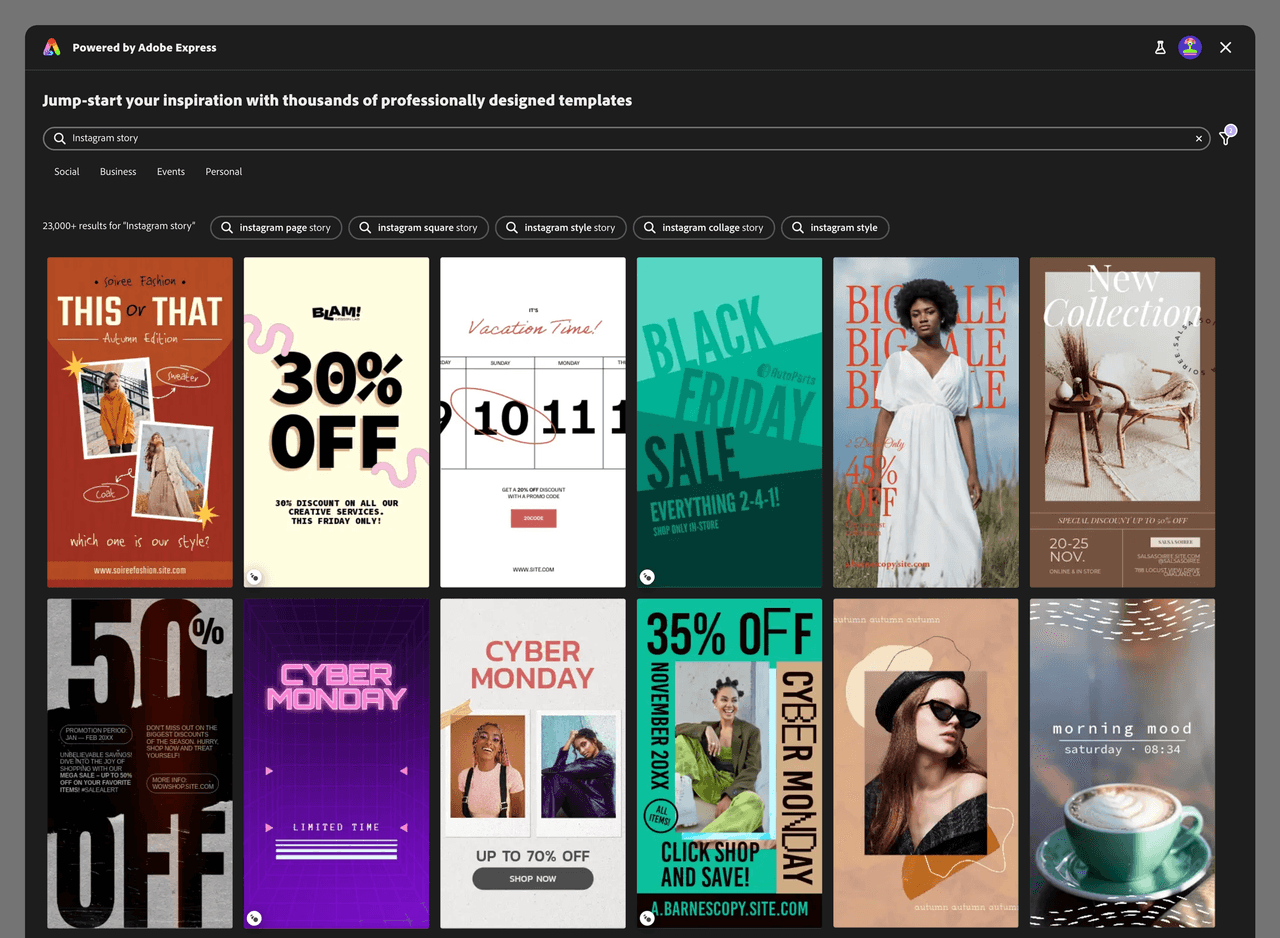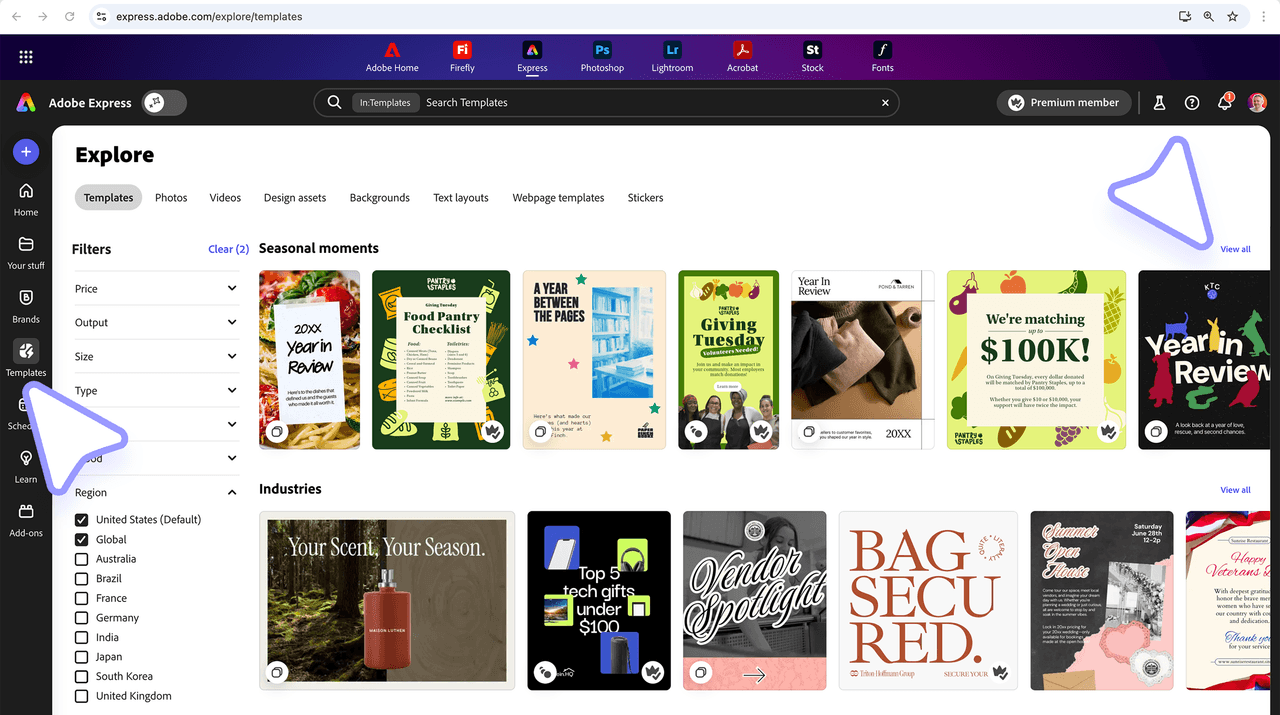Template Browser
The Template Browser is a feature in the Adobe Express Embed SDK designed for template discovery and editing.
It allows users to browse through a wide array of templates, find one that suits their needs, and then open it in the full editor for customization. This workflow is ideal for integrations where users may not have a specific template in mind and need inspiration or guidance.

How the Template Browser Works
The Template Browser is a Workflow that launches a customizable browsing experience. Users can explore template collections, use search and filtering capabilities to narrow down their options, and select a template to edit. The entry point for this module is the startFromContent() method.
Copied to your clipboardawait import("https://cc-embed.adobe.com/sdk/v4/CCEverywhere.js");const { module } = await window.CCEverywhere.initialize({ clientId: "your-client-id", appName: "your-app-name" },{});module.startFromContent({ /* ... */ });
Understanding Collections
Collections are organizational structures that group related templates together, forming the foundation of the Template Browser experience. Understanding how collections work is essential to effectively using the Template Browser.
Collections vs. Templates
A collection is a container that holds multiple templates, organized around a theme, use case, or design style. Collections enable curated experiences that guide users toward specific types of content. For example, a "Business Cards" collection might contain templates for different industries, layouts, and color schemes—all unified by the common purpose of creating business cards.
A template is an individual design file within a collection. Each template represents a complete, editable design that users can customize. When users select a template from the Template Browser, they're choosing a specific template from within a collection.
Template editing vs. Collection browsing
If you need to directly open a specific, known template and not let users browse a collection, use the editor.createWithTemplate() API instead of the Template Browser experience.
Collection Identifiers (URNs)
The Collection ID should be provided as a URN, i.e., a long string like the following:
Copied to your clipboardurn:aaid:sc:VA6C2:34756608-9fa0-4fdc-80b0-65e17ffb29c8
Collections fed to the Template Browser are those that are publicly available in Adobe Express. To get a Collection ID, follow the instructions below:
- Click the Templates button in the left toolbar.
- Find the collection you want to use—using either Filters or Search.
- On the righthand side, opposite to the Collection name, click the "View all" link.

- You'll be redirected to the Collection details page.
- Copy the last part of the page's URL; the URN is the string that starts with
urn.

- This is the URI-encoded URN; in order to use it, you need to decode it. Either manually replace all the
%3Ainstances with a:in the string, or use the JavaScript functiondecodeURIComponent(); for example, in the Browser's console.
Copied to your clipboarddecodeURIComponent("urn%3Aaaid%3Asc%3AVA6C2%3A34756608-9fa0-4fdc-80b0-65e17ffb29c8");// "urn:aaid:sc:VA6C2:34756608-9fa0-4fdc-80b0-65e17ffb29c8"
Public and Custom Collections
Public collections are those made available by Adobe Express to all users. These collections represent the broad library of templates accessible through the Adobe Express platform.
If you wish to create your own Custom collections, to control exactly which templates users see and allowing for brand-specific experiences or industry-focused content, please reach out to your Adobe point of contact. They will be able to help you create the collections and provide you with the respective URNs.
Hierarchical Collection Structures
Custom collections can have a parent (root) collection, which is the one containing all other collections. For example, you may have a Business Cards root collection, which contains themed Business Card collections (square, landscape, etc.).
The parent collection is configured in the rootCollectionId property.
Configuring the Template Browser
The Template Browser introduces several new feature configurations to the appConfig.contentBrowseConfig object. They can be independently enabled or disabled to customize the module according to your needs.
Copied to your clipboard// ...const appConfig = {contentBrowseConfig: { // 👈 Configure the Template Browser here/* ... */},};module.startFromContent(appConfig);
All the features discussed below are properties of the contentBrowseConfig object.
Collection Configuration
The collection to pre-populate the Template Browser with is configured in the categoriesConfig array. It contains one object, with a category property (always equal to the "templates" string) and a collectionId with the URN of the collection.
Copied to your clipboardconst appConfig = {contentBrowseConfig: { // 👈 Configure the Template Browser experiencecategoriesConfig: [{category: "templates", // 👈 Always "templates"collectionId: "urn:aaid:sc:...", // 👈 The URN of the collection},],},};
Additionally, a collectionItemsSortOrder can be provided to sort the items in the collection.
Search and Discovery Features
The Template Browser includes search functionality that helps users find templates matching their needs. The searchQuery property allows you to pre-populate the search field with terms relevant to your integration's context. For example, if your application focuses on social media content creation, you might pre-populate with "Instagram story" to immediately show relevant templates.
Search suggestions, configured via shortcutPillTerms, provide quick-access buttons below the search bar. These shortcuts enable users to quickly filter templates by common categories or themes without having to type.
Additionally, you can hide the search bar and filters via the hideSearchBar and hideFilters properties.
Copied to your clipboardconst appConfig = {contentBrowseConfig: {searchQuery: "Instagram story",shortcutPillTerms: ["Social", "Business", "Events", "Personal"],hideSearchBar: false, // false by defaulthideFilters: false, // false by default},};
When a Collection ID is used, shortcutPillTerms are disabled. When a specific collection is configured, these shortcut pills are disabled because the collection itself already provides focused content, making additional filtering redundant.
Customization and Branding
Finally, you can customize the text to be displayed in the header of the module via the headerText property.
Copied to your clipboardconst appConfig = {contentBrowseConfig: {headerText: "Browse our Business Card templates",},};
When to Use the Template Browser
The Template Browser is best suited for scenarios where content discovery is a primary goal. Use this module when you want to:
- Allow users to explore a wide range of design options without a predetermined choice.
- Provide inspiration and creative starting points for projects.
- Offer curated collections tailored to specific themes, industries, or branding guidelines.

